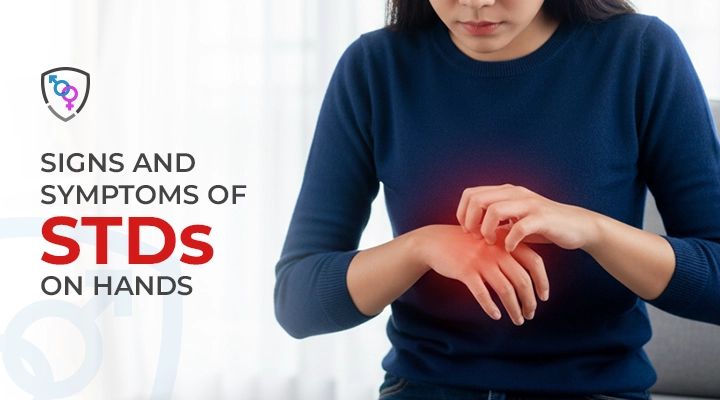Noticing unusual rashes, bumps, or skin peeling on your hands can feel alarming, and it’s natural to wonder, Could this be an STD?
While it’s rare for sexually transmitted diseases (STDs) to affect the hands directly, some infections can cause visible skin changes in this area. Understanding the difference between STD-related rashes and other skin conditions helps you take the right next steps — testing, treatment, and peace of mind.
Let’s break down what to look for, which infections may show up on the hands, and when to see a healthcare provider.
Can STDs Appear on the Hands?
Yes, though it’s uncommon. Certain viral, bacterial, or fungal STDs can produce skin symptoms on the hands due to:
- Direct contact with infected fluids or open sores
- Self-inoculation (spreading an infection from one body part to another)
- Systemic infection, where the bacteria or virus affects the skin as part of a body-wide reaction
These symptoms are usually not limited to the hands; they often appear alongside other signs of infection elsewhere in the body.
Common STDs That May Affect the Hands
HPV (Human Papillomavirus)
HPV can cause warts on the fingers, palms, or around the nails, often called common or flat warts.
- Usually painless but contagious through direct skin contact.
- Warts may look rough, raised, or cauliflower-like.
Syphilis
In secondary syphilis, a hallmark symptom is a rash on the palms and soles.
- Appears as red or brown flat spots or slightly raised lesions.
- May accompany fever, swollen lymph nodes, sore throat, or fatigue.
Gonorrhea
Though gonorrhea rarely affects the hands directly, it can spread through the bloodstream, leading to disseminated gonococcal infection (DGI).
- DGI can cause small pustules, red patches, or painful joints.
Chlamydia
Chlamydia doesn’t typically cause rashes on the hands, but it can trigger Reiter’s Syndrome (reactive arthritis) — a triad of joint pain, eye inflammation, and skin rashes.
- Some may notice dryness or peeling skin on the hands related to this immune response.
Fungal or Yeast-Related Infections
Some fungal infections transmitted through sexual contact can lead to redness, dryness, or peeling on the hands, especially if there’s frequent moisture exposure or contact with infected areas.
- Commonly mistaken for eczema or dermatitis.
- Usually respond well to topical or oral antifungal treatments.
What STD Causes Rash or Peeling on Hands?
Here’s a quick comparison:
| STD | Typical Hand Symptoms | Other Common Symptoms |
| Syphilis | Rash on palms | Fever, mouth sores, fatigue |
| HPV | Warts or bumps | Genital warts, itching |
| Fungal/Yeast | Peeling, dryness, redness | Itching, irritation |
| Gonorrhea | Rare rash or pustules | Joint pain, discharge |
STD vs Non-STD Skin Conditions
Not all rashes or peeling are sexually transmitted. Common non-STD causes include:
- Eczema or contact dermatitis (reaction to soaps or chemicals)
- Psoriasis (thick scaly patches)
- Fungal infections unrelated to sexual contact
- Dry skin or allergic irritation
If symptoms don’t improve with moisturizers or over-the-counter creams or if you’ve had recent sexual exposure, testing is essential to rule out an STD that causes blisters on hands or dryness.
Associated Symptoms to Watch For
If you notice hand rashes along with any of these, seek medical care promptly:
- Fever, fatigue, or swollen glands
- Sores or discharge around genitals or mouth
- Joint pain or swelling
- Rash on both hands and feet (possible syphilis)
Diagnosis and Testing
Healthcare professionals diagnose STDs through:
- Physical exams to assess rash patterns
- Blood tests for syphilis, HIV, or other infections
- Swab or urine tests for chlamydia and gonorrhea
- Visual examination for HPV or fungal infections
If you’re unsure which STD could be causing your symptoms, book a Comprehensive STD Panel through Manhattan STD Testing to get tested for all major infections in one visit.
Treatment Options
Treatment depends on the underlying infection:
- Antibiotics for bacterial STDs (syphilis, gonorrhea, chlamydia)
- Antivirals for HPV to reduce wart recurrence
- Antifungal creams or oral medication for yeast or fungal STDs
- Supportive care for inflammation or peeling skin
Prevention Tips
- If you’ve had unprotected sex, use condoms or dental dams to reduce the risk of infection and maintain safer sexual health.
- Wash hands thoroughly after sexual contact.
- Avoid touching visible sores or warts.
- Maintain personal hygiene and get regular screenings.
When To See A Doctor
Seek medical attention if you have:
- Persistent or spreading rashes or blisters
- Pain, discharge, or swelling
- Recurrent or unexplained hand symptoms
- Any new skin change after potential sexual exposure
Conclusion
While STDs on hands are uncommon, they can happen through direct contact or systemic infection. Rashes, peeling, or bumps on your hands don’t always signal an STD, but only testing can tell for sure.
If you’re experiencing hand symptoms and are sexually active, book a confidential STD test with Manhattan STD Testing. Early testing and treatment protect your health and prevent spreading infections, and getting answers offers peace of mind.
Frequently Asked Questions
Can regular hand lotion or soap cause irritation that looks like an STD?
Yes. Some soaps, sanitizers, or scented lotions can cause contact dermatitis, which may mimic STD-related dryness or rashes. If irritation persists despite changing products, seek medical advice.
Are STDs on hands contagious through casual touch or handshakes?
No. STDs on hands are not spread through casual touch, handshakes, or shared objects. Transmission usually requires direct contact with infected fluids or sores.
How long after noticing a hand rash should I get tested?
If a rash or peeling lasts more than a few days without improvement, especially after sexual contact, testing within a week is recommended to rule out infection.
Can stress or a weak immune system make hand rashes from STDs worse?
Yes. A weakened immune system can intensify skin symptoms and delay healing, making professional evaluation and treatment even more important.
Disclaimer
This blog is for informational & educational purposes only and does not intend to substitute any professional medical advice or consultation. For any health-related concerns, please consult with your physician, or call 911.

-
About The Author
Dr. Syra Hanif M.D.Board Certified Primary Care Physician
Dr. Syra Hanif is a board-certified Primary Care Physician (PCP) dedicated to providing compassionate, patient-centered healthcare.


